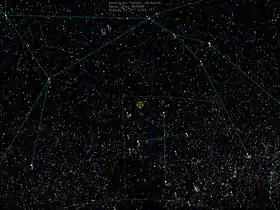 Star map shows star position on the northern edge of the constellation Crux | |
| Observation data Epoch J2000 Equinox J2000 | |
|---|---|
| Constellation | Crux |
| Right ascension | 12h 46m 22.71460s[1] |
| Declination | −56° 29′ 19.7366″[1] |
| Apparent magnitude (V) | 4.62[2] |
| Characteristics | |
| Evolutionary stage | Main sequence |
| Spectral type | B2/3V[3] |
| U−B color index | −0.61[2] |
| B−V color index | −0.150±0.003[2] |
| Astrometry | |
| Radial velocity (Rv) | 15.5[4] km/s |
| Proper motion (μ) | RA: −33.03[1] mas/yr Dec.: −14.84[1] mas/yr |
| Parallax (π) | 8.48 ± 0.22 mas[1] |
| Distance | 385 ± 10 ly (118 ± 3 pc) |
| Absolute magnitude (MV) | −1.05[5] |
| Details | |
| Mass | 6.0±0.1[6] M☉ |
| Luminosity | 402[7] L☉ |
| Surface gravity (log g) | 4.24[8] cgs |
| Temperature | 16,780[9] K |
| Rotational velocity (v sin i) | 22±3[9] km/s |
| Age | 8.2±1.8[6] Myr |
| Other designations | |
| Database references | |
| SIMBAD | data |
HD 110956 is a single[10] star in the southern constellation of Crux. It is faintly visible to the naked eye with an apparent visual magnitude of 4.62.[2] The distance to this star is approximately 385 light years based on parallax and it is drifting further away with a radial velocity of 15.5 km/s.[4] It is a probable member of the Lower Centaurus–Crux subgroup of the Scorpius–Centaurus association.[11]
This is a B-type main-sequence star with a stellar classification of B2/3V.[3] It is a young star, estimated to be about 8 million years old, with six times the mass of the Sun.[6] The star is spinning with a projected rotational velocity of 22 km/s.[9] It is radiating around 400[7] times the luminosity of the Sun from its photosphere at an effective temperature of 16,780 K.[9]
There are multiple visual companions positioned near HD 110956. The brightest of these, with a visual magnitude of 8.93, is located at an angular separation of 51.1″ along a position angle of 166°, as of 2020. This companion was reported by J. F. W. Herschel in 1834.[12] It is an α2 CVn variable with the designation BR Cru.[13]
References
- 1 2 3 4 5 van Leeuwen, F. (2007). "Validation of the new Hipparcos reduction". Astronomy and Astrophysics. 474 (2): 653–664. arXiv:0708.1752. Bibcode:2007A&A...474..653V. doi:10.1051/0004-6361:20078357. S2CID 18759600.
- 1 2 3 4 Anderson, E.; Francis, Ch. (2012). "XHIP: An extended hipparcos compilation". Astronomy Letters. 38 (5): 331. arXiv:1108.4971. Bibcode:2012AstL...38..331A. doi:10.1134/S1063773712050015. S2CID 119257644.
- 1 2 Houk, N.; Cowley, A. P. (1975). University of Michigan Catalogue of two-dimensional spectral types for the HD stars. Volume I. Declinations -90_ to -53_ƒ0. Bibcode:1975mcts.book.....H.
- 1 2 Evans, D. S. (June 20–24, 1966). "The Revision of the General Catalogue of Radial Velocities". In Batten, Alan Henry; Heard, John Frederick (eds.). Determination of Radial Velocities and their Applications, Proceedings from IAU Symposium no. 30. University of Toronto: International Astronomical Union. Bibcode:1967IAUS...30...57E.
- ↑ Kaltcheva, N. T.; et al. (2014). "Massive stellar content of the Galactic supershell GSH 305+01-24". Astronomy and Astrophysics. 562: A69. arXiv:1312.5592. Bibcode:2014A&A...562A..69K. doi:10.1051/0004-6361/201321454. S2CID 54222753.
- 1 2 3 Tetzlaff, N.; et al. (January 2011). "A catalogue of young runaway Hipparcos stars within 3 kpc from the Sun". Monthly Notices of the Royal Astronomical Society. 410 (1): 190–200. arXiv:1007.4883. Bibcode:2011MNRAS.410..190T. doi:10.1111/j.1365-2966.2010.17434.x. S2CID 118629873.
- 1 2 McDonald, I.; et al. (2012). "Fundamental parameters and infrared excesses of Hipparcos stars". Monthly Notices of the Royal Astronomical Society. 427 (1): 343–357. arXiv:1208.2037. Bibcode:2012MNRAS.427..343M. doi:10.1111/j.1365-2966.2012.21873.x. S2CID 118665352.
- ↑ de Geus, E. J.; et al. (June 1989), "Physical parameters of stars in the Scorpio-Centaurus OB association", Astronomy and Astrophysics, 216 (1–2): 44–61, Bibcode:1989A&A...216...44D
- 1 2 3 4 Bragança, G. A.; et al. (November 2012). "Projected Rotational Velocities and Stellar Characterization of 350 B Stars in the Nearby Galactic Disk". The Astronomical Journal. 144 (5): 10. arXiv:1208.1674. Bibcode:2012AJ....144..130B. doi:10.1088/0004-6256/144/5/130. S2CID 118868235. 130.
- ↑ Eggleton, P. P.; Tokovinin, A. A. (September 2008), "A catalogue of multiplicity among bright stellar systems", Monthly Notices of the Royal Astronomical Society, 389 (2): 869–879, arXiv:0806.2878, Bibcode:2008MNRAS.389..869E, doi:10.1111/j.1365-2966.2008.13596.x, S2CID 14878976.
- ↑ de Zeeuw, P. T.; et al. (January 1999), "A HIPPARCOS Census of the Nearby OB Associations", The Astronomical Journal, 117 (1): 354–399, arXiv:astro-ph/9809227, Bibcode:1999AJ....117..354D, doi:10.1086/300682, S2CID 16098861
- ↑ Mason, Brian D.; et al. (2001). "The 2001 US Naval Observatory Double Star CD-ROM. I. The Washington Double Star Catalog". The Astronomical Journal. 122 (6): 3466. Bibcode:2001AJ....122.3466M. doi:10.1086/323920.
- ↑ Samus', N. N.; et al. (2017). "General catalogue of variable stars". Astronomy Reports. 5.1. 61 (1): 80–88. Bibcode:2017ARep...61...80S. doi:10.1134/S1063772917010085. S2CID 125853869.